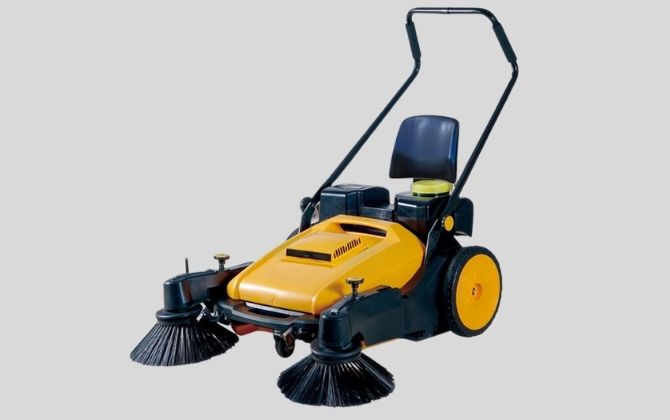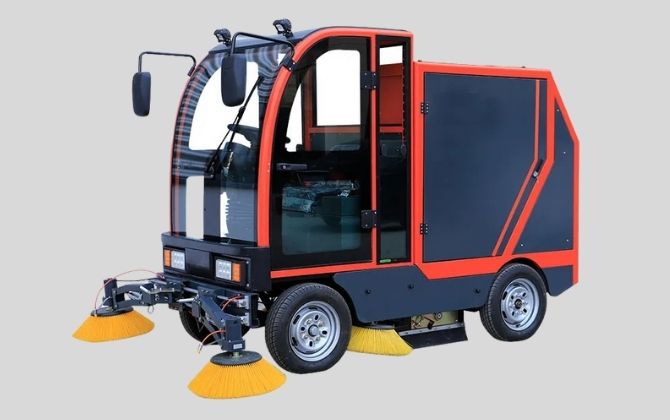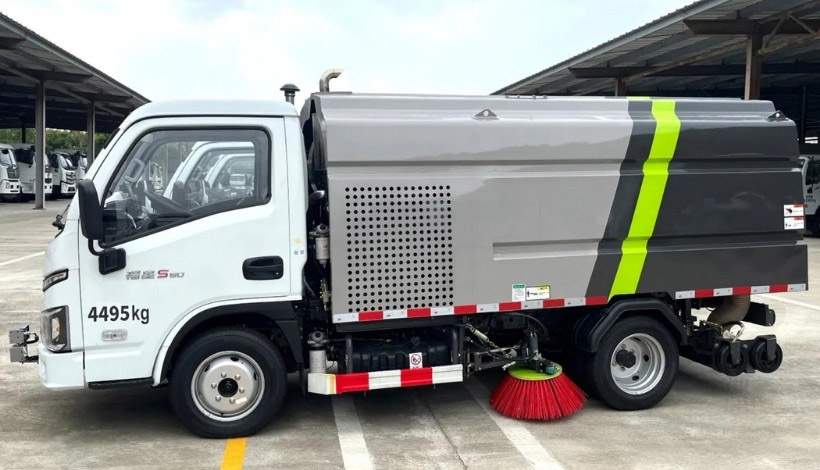Pavements, driveways and outdoor paved areas need a little care to stay good all year. Over time, dirt, oil stains, moss and weeds can build up. Before you know it, your pavement can start looking dull and tired.
Today, you will learn how you can clean pavement with different tools, machines and techniques. We will also tell you the preparation and maintenance required for paved routes.
4 Pavement Cleaning Methods
There are different pavement cleaning techniques you can use. Basically, it depends on the type of dirt, stains and surface.
Mechanical Cleaning
Mechanical cleaning is one of the most commonly used ways to clean pavement. Because, this method is quick and you don’t require water and chemicals. You can try it for your small areas with a hand broom.
But for bigger spaces, you have to use a mechanical sweeper. These machines work fast and can cover large surfaces for sweeping. You can clear dust, leaves and debris from your driveways, parking lots and sidewalks.
High Pressure Washer
By this technique, you can clean the hard surface with a washer which has a strong jet of water. This high pressure water can easily remove mud, oil stains and tough dirt from your roads. Its powerful spray can reach corners and cracks where brooms cannot. In this way, you can save your time and do a deep clean.
These washers easily push out water at a pressure of about 1,500 to over 3,000 PSI (110 to 130+ bars). But, you must handle the washer carefully because too much pressure can damage weaker surfaces.
Chemical Cleaner
You should use chemical cleaning techniques when water and sweeping cannot handle stains/dirt. For example: you can use them for oil spills, grease marks & deep stains on concrete/asphalt pavement.
Basically, chemical based cleaners break down the dirt, so you wash it away easily. It is best for the cleaning of parking lots, driveways and industrial floors. Always remember to follow the instructions and wear safety gear when you work with chemicals.
Sand Replacement
After deep cleaning (with pressure washers), you will see that sand between blocks may be washed away. Then, you can’t clean the pavement surfaces properly to make it smooth for driving & walking.
In this case, you should sweep fresh sand into the open joints. Mostly, you can apply this method once you have done the dirt removal process. It will make your road surface clean as well as secure.
Preparation of Pavement For Cleaning
Before you start cleaning, you must prepare the pavement in the right way. The reason is, good preparation makes the whole process easier and provides you better results.
Gather Right Supplies
You should collect all the tools and materials according to the cleaning method you want to apply. These include things such as brushes, brooms, pressure washers and safety items (googles, gloves & respirators). When you organize your supplies first, you can work smoothly and with less hassle.
Check For Stains and Spills
You have to assess the condition of the surface for any stains, oil spots or spills. Right identification helps you to decide which cleaning method you should use. For example: sweeping technique for light dust, a pressure washer for tough grime and chemical cleaners for oil and tough stains.
Protect Nearby Plants & Surfaces
It’s important to shield anything around the pavement. Because water, strong cleaners, & high pressure can harm plants, walls and nearby surfaces. That’s why you should cover plants with plastic sheets or move pots away. Further, keep water spray and chemicals directed only at the pavement.
Pavement Cleaning: Step-By-Step Process
1. Removing All Dirt or Debris
Firstly, you have to remove loose first, leaves and debris from the pavement surface. For that purpose, you can use either a sweeping method with a broom, brush or mechanical sweeper for larger areas.
Most importantly, you should pay attention to corners and edges where debris can collect. If you clear these materials, it will make the next clawing step easy for you.
2. Weeds Removal
Now check the pavement for unwanted plant growth between cracks and joints. To clean weeds, you can use weeding equipment for hard spots or can pull them out by hand as well.
In this way, it makes your pavement look clean and also prevents damage to the surface over time. You have to make sure that roots are removed completely. So, the wild plants can stop growing back quickly.
3. Wash With Water & Soap
The next step is to wash the pavement with water and gentle (mild) soap. To apply soapy water, you should use a bucket, hose or pressure washer. You also scrub dirty spots with a brush if needed. This way will remove dust, grime and light stains marks.
4. Stains Removal: Oil and Grease
As you know, oil and grease can leave dark marks on your pavement. To remove them, you must apply a suitable cleaner or degreaser directly on the stain. Now let it sit for a few minutes, so oil can break down.
After that, scrub the area with a stiff brush and wash off with clean water. Well, you can also try these DIY cleaners for cleaning or pavement discoloration.
- Baking Soda: You can use baking soda to clean oil and grease marks on the road.
- Kitty Litter: It can be beneficial to remove fresh oil stains.
- Coca-Cola: A small amount of coca cola can really work to clean rust or stubborn spots.
- Laundry Detergent: Mixture of detergent and water can clear the grease & dirt stains.
5. Pressure Washer For deep Cleaning
Finally, it’s time to deep clean the pavement. It will clean off any remaining dirt, marks, or left over soap as well. You should adjust the water pressure according to the type of pavement, so you can avoid further damage.
Also, move the spray evenly across the roadway surface. Additionally, always pay attention to corners and edges of the path. This step will make your pavement look fresh, clean and ready for use.
How To Clean Block Paving?
Block paving cleaning is different from regular pavement. The major reason is the gaps you find between the blocks. You need to remove weeds and moss from both the surface and the joints. Following are some block pavement cleaning methods you can use.
Block Paving Cleaner
You can use a cleaner especially made for block paving. With its help, you can clean dirt, moss and algae. You need to apply it on the surface and leave for a few minutes. Then scrub or rinse with water to make the blocks look fresh and clean.
Steam Clean
Steam cleaning works with hot steam to eliminate build up from block paving. You can simply move the steam nozzle over the surface you want to clean. Then, the heat will soften dirt and kill unwanted plants. In addition, this approach is eco-friendly because it uses little or no chemicals. Plus, It’s effective for deep cleaning joints but also clean tight spaces between blocks.
Simple Clean
A simple clean is basically a quick way to clear your block paving on a daily basis. You can sweep the surface with a broom & brush to remove loose dirt and small debris. This basic cleaning will keep the paving neat and prevents dirt from collecting over time
Pressure Wash
It is the most popular and effective way to clean block surfaces. You will require a pressure washer to spray water at high force. It will clear away dirt, grime and moss.
This method also works well for tough marks and areas that you cant sweep with simple clean. You must adjust the water pressure based on the block paving surface.
Residential Paving – Cleaning & maintenance
Natural Stone Paving
Actually, natural stone paving is made with real stone such as granite, slate & limestone. It is strong, durable and gives a stylish look to driveways and walkways. But, it can be easily stained or damaged by harsh chemicals. This will really make the stone paving texture unsafe for use. Below are some cleaning techniques for every type of natural stone.
- Granite/Slate: You must start by removing debris and weeds from the pavement. Then wash the surface with soap, water & suitable cleaners for tougher marks. Finally, rinse it and let it dry to keep the pavement clean and safe to use.
- Sandstone: To clean it, you can mix warm water with a mild detergent. Then pour it over the paving. Now, scrub the surface with a stiff brush until it looks clean. Allow the pavement surface to dry for at least one day.
- Marble: Clean all dust from the surface. Now apply pH-neutral soap with soft cloth to avoid scratch. After that, you can wash the area with clean water to maintain its natural shine and elegance.
- Limestone: Limestone has a soft surface, so gently sweep it with a soft brush. It will remove all dirt & debris. Now use a mop with no acidic soap for scrubbing. Let sit this material for 30 min and then wash the surface with warm water.
Pavement of Faux Stone (Man Made Stone Paving)
You will notice that faux stone paving looks like natural stone but is generally lighter and easier for you to clean. Some examples are: tarmac paving, gravel paving and resin-bonded paving. Below are common types of man made paving and how you can wipe them.
- Brick: Apply the mixture of warm water and bleach to brick paving with a stiff brush. If you see any stains, gently clean it with a scrub again. Never use high pressure water, it can wash away sand between bricks.
- Concreto: Firstly, brush away any weeds from the concrete. Now, mix a non acidic cleaner with water and apply it over the surface. Scrub gently with a soft brush and rinse well with a garden hose.
- Porcelain Tiles: To clean this type of pavement, you need to sweep the tiles with a soft brush. Then, combine a pH-neutral cleaner with hot water and pour it over the tiles. You must leave it for about 10 minutes without letting it dry. Now you can wash it with water.
Paving Cleaning Machine (Required Tools)
When you use high tech paving cleaning machines, it will make the cleaning process fast and more effective. These equipment can easily tackle dirt and moss.. Following is the list of important tools you can use to keep your pavement clean and well-maintained.
- Broom/outdoor brush
- Weed Brush machine
- Weed preventative
- Power washer & water
- Cleaning products (chemical/natural)
- Rubber gloves & work shoes



Maintenance of Pavement – Expert Tips
Once you clean the pavement then regular maintenance will keep your pavement looking good and durable. You have to take care of stains and dust layers. In this way, you can prevent costly repairs.
- Sweep Regularly: When you sweep your pavement, dirt, leaves and debris can easily be removed. Hence, you will see no build up of grime and the surface will be safe to walk.
- Clean Spills Quickly: Clean spills such as oil, grease and food right away. Your on time action can stop stains and damage to the pavement.
- Seal the Pavement: You must apply a sealant to protect your pavement from water. It will also maintain surface appearance and extend its life.
- Early Weeds Removal: It is important to remove weeds as soon as they appear between cracks. This stops their growth and damages the pavement.
- Avoid Harsh Chemicals: You always use non toxic cleaners instead of strong chemicals. Because, strong chemicals can damage the surface and cause discoloration.
- Limit Heavy Loads: Excess weight on path can cause cracks or surface harm over time. So, you should avoid parking and driving heavy vehicles on your pavements.
- Seasonal Deep Cleaning: It is necessary to do cleaning after every few months or during seasonal changes. This removes stubborn dirt, moss and algae.
- Repair Cracks: When you notice any cracks or chips, you must fix them as soon as possible. Because, early repair prevents severe damage and keeps the pavement smooth.
Conclusión
Pavement cleaning not only improves the look of your area, but it also promotes safety and durability. Hence, if you invest a little effort in maintenance today, it will keep your walkways, driveways & patios functional.
Therefore, you should follow a regular cleaning routine and use the right techniques according to surface demand.


-80x69.png)

